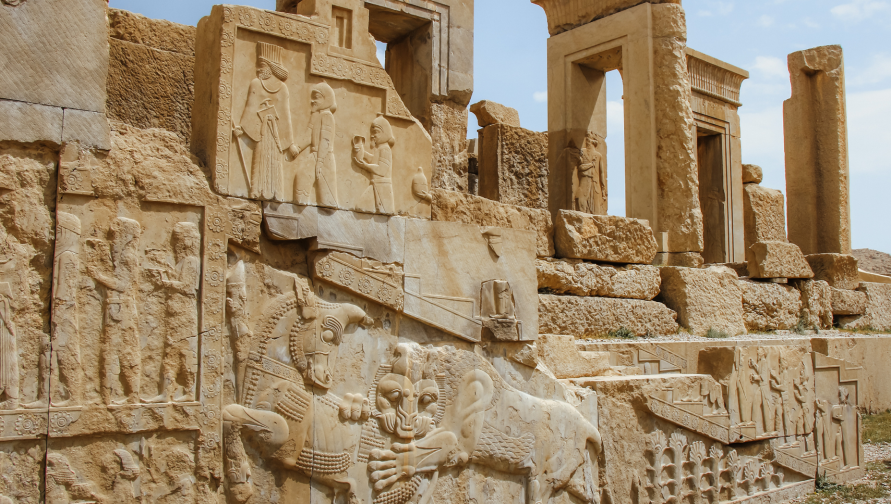
Nowruz, meaning “New Day,” is the most important celebration among Iranians and their neighbors in Asia. According to Iranian belief, the spring equinox marks the changing of the year, the regeneration of life and a new birth of the world. This is the basis of the Nowruz celebration, with three millennia of tradition behind it.
Below, Touraj Daryaee, director of UCI’s Samuel M. Jordan Center for Persian Studies and Culture and Maseeh Chair in Persian Studies and Culture, dives into the holiday’s rich origins and history:
During Nowruz, Iranians from various religious, ethnic and linguistic backgrounds come together to greet the New Year in their homes and hope for a better year to come. Streets bustle with activity where one can see thousands of goldfish in bowls to ornament the traditional Nowruz table, and children anxiously await gifts from their elders. Parents shop for new shoes and clothes for their children to wear, in line with the symbolic theme of renewal and renovation.
Everyone eagerly awaits the exact moment when the earth passes the point of equinox and brings about the start of the New Year on March 21. It’s a time of rejuvenation and hopefulness for a better year to come.
The story of Nowruz, or the Iranian New Year, is wrapped in myths and legends beautifully told in the great Persian epic, The Shahnameh or Book of Kings. The story goes that when Jamshid, one of the earliest and greatest of the mythical kings of Iran, ascended the throne, he organized the realm and brought culture to the people. He then made a throne studded with jewels and was able to have it elevated by supernatural beings to reach the heavens. As he sat on the throne in the sky like the sun shining above, “the world’s creatures gathered in wonder about him and scattered jewels on him and called this day the New Day, or Now Ruz.” (Ferdowsi, 2006, 7).
According to this Persian tradition, during the Nowruz, people put aside their differences, rested and made a great feast which included much wine and music. Henceforth, no one knew of sorrow, sadness or death. This is the legendary history of the Nowruz, memorized by children in Iran, Afghanistan, Tajikestan as well as those expatriates living in other countries today.
The Shahnameh is a thousand years old, but it is conceivable that the story was known even a thousand years before then. There is even pictorial evidence as early as 2,500 years ago that the Iranians celebrated the Nowruz with pomp and circumstance.
Some suggest that during the heyday of the great empire of antiquity–the Achaemenid Persian Empire (550-330 BCE)–the great ceremonial capital Persepolis, was used as a staging ground for the New Year celebrations. The interesting scene of the lion devouring the bull on the Apadana palace at Persepolis may symbolize the end of winter and the beginning of spring. At the side of the Apadana palace in Persepolis, rows of people from Africa, Europe and Asia are shown in procession. They bring gifts representing the best artisanry of their country, which may relate to the idea of gift-giving at the Nowruz. Emissaries in perfect order, some holding flowers and others holding each other’s shoulders or hands, are etched in stone at the palace, portraying the celebratory nature of Nowruz.
Isfahan, at the heart of the Iranian land, is the jewel. The 10th century Muslim author, Ibn Hawqal, describes the Nowruz celebration as such:
During the Nowruz festival, people gather for seven days in the bazaar of Katrina, a suburb of Isfahan, engaged in merriment; they enjoy various foods and go around visiting decorated shops. The inhabitants, and those coming from other places to participate in this festival, spend a good deal of money, wear beautiful clothes and take part in gatherings for plays and merrymaking. Skillful singers, both male and female, take their places side by side on the riverside along the palaces. The whole atmosphere is filled with joy and happiness. Many assemble on the rooftops and in the markets, engage in festivities, drinking, eating and consuming sweets, not letting an idle moment to pass by.
In the 16th and 17th centuries, the Safavid Shahs of Iran also celebrated the Nowruz with great fanfare. The French traveler Jean Chardin, who visited Iran in the 17th century, beautifully describes the activities of the Safavid court at the time. According to him, eggs, gilded and colored with special scenes, were given as presents. At the court, dancers, musicians and singers entertained the crowd, while the court astronomer looked to the sky to call the exact time for the beginning of spring. At the moment the Nowruz was called, there was huge commotion: Firecrackers, muskets and cannons were fired, and bands played music. Shouts of joy filled the air and wild rue (isfand) was sprinkled into the fire so that the air would smell pleasant.
As early as a century ago, in Tehran and many other places, the Nowruz was celebrated on the last Wednesday before the New Year by lighting bonfires. People would jump over these fires while saying “my yellowness to you and your redness to me.” This phrase symbolized the letting go of ailments (“my yellowness”) and the invitation to good health (“your redness to me”). The Nowruz was sounded off by cannons, and then the young would kiss the hands and feet of the elders, at which point they would be presented with gold or silver coins. Wearing fine new clothes, they would visit each other’s homes until the 13th day of the Nowruz.
These very same practices continue today in Tehran and most of Iran. People eagerly await the coming of the Nowruz as a time of joy, hope and renewal of life.
To learn more about UCI’s Samuel M. Jordan Center for Persian Studies and Culture, visit the website here.
